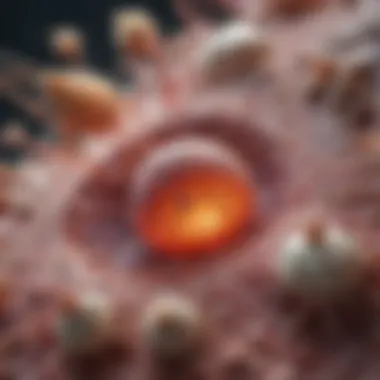Basal Cell Carcinoma Prognosis: Key Insights


Intro
Basal cell carcinoma (BCC) stands as the most common form of skin cancer, often stemming from prolonged exposure to ultraviolet (UV) radiation. This cancer predominantly affects the skin's basal cells, which are responsible for producing new skin cells. Given its prevalence, understanding the prognosis of BCC is paramount. A clear grasp of the factors impacting outcomes can significantly assist healthcare professionals and patients alike.
The prognosis of BCC varies widely. Factors such as tumor size, location, and histological subtype play critical roles in determining the clinical outcomes of affected individuals. Additionally, a patient's overall health and the presence of immune suppression can further complicate prognostic assessments.
In this exploration, we aim to dissect various elements influencing the prognosis of BCC, including treatment modalities, recent research findings, and their implications for patient management. An emphasis will be placed on elucidating the biology underpinning BCC in order to provide a substantive foundation for understanding how these factors interplay with prognosis.
As we progress, readers will gain valuable insights and knowledge relevant to both clinical practice and research, enhancing their understanding of the complexities associated with basal cell carcinoma.
Understanding Basal Cell Carcinoma
Understanding basal cell carcinoma (BCC) is crucial for grasping its prognosis and management. This common form of skin cancer plays a significant role in public health, given its growing incidence rates. The insights into BCC help in determining appropriate intervention strategies and improving patient outcomes.
Definition and Overview
Basal cell carcinoma originates from the basal cells in the epidermis. These cells are responsible for new skin production. BCC often manifests as a small, pearly bump on sun-exposed areas of the body. The lesion typically appears raised with a shiny surface. It may also present as a flat, scaly patch. While BCC is rarely life-threatening, its potential for local invasion makes understanding its characteristics vital. Recognizing this can enhance early detection and treatment.
Epidemiology and Incidence Rates
The epidemiology of basal cell carcinoma indicates a notable increase in incidence. Studies reveal that BCC is the most prevalent skin cancer type worldwide. In the United States, over four million cases are diagnosed annually. Factors contributing to this rise include increased sun exposure, tanning bed use, and aging populations. Understanding these rates is essential for developing effective prevention strategies.
Types of Basal Cell Carcinoma
There are several types of basal cell carcinoma, each with distinct characteristics that impact prognosis and treatment.
Superficial BCC
Superficial BCC is characterized by its flat, scaly appearance. This type typically grows slowly and is often found on the trunk or limbs. One key reason for its inclusion is its ease of detection and favorable treatment outcomes. Superficial BCCs respond well to topical treatments or minor surgical procedures. This capability makes them a popular subject in discussions about early intervention and management strategies.
Nodular BCC
Nodular BCC is the most common form of basal cell carcinoma. It usually presents as a pearly or waxy bump. The distinct feature of nodular BCC is its more aggressive growth pattern compared to superficial BCC. Treatments for this type often require surgical excision. Understanding nodular BCC is vital for recognizing its potential to invade surrounding tissues, which underscores the need for precise management.
Sclerosing BCC
Sclerosing BCC can be more difficult to diagnose early due to its subtle presentation. It commonly appears as a scar-like lesion and is known for its infiltrative growth. The unique characteristic of this type is its potential to extend beyond visible borders, making it more challenging to treat. This aspect underscores the importance of timely intervention and close monitoring.
Fibroepithelial BCC
Fibroepithelial BCCs have a distinct mix of fibrous and epithelial components. This type is less common and may resemble benign skin lesions. Its rarity and possible confusion with other dermatological conditions highlight the need for accurate diagnosis. The biopsy and histological analysis are critical for proper treatment planning.
Understanding the various types of basal cell carcinoma helps refine treatment approaches and informs prognosis discussions. Gathering knowledge about these different presentations can aid in improving early detection and management practices.
Prognostic Factors in Basal Cell Carcinoma
Understanding the prognostic factors in basal cell carcinoma is crucial in determining patient outcomes. This section aims to explore various elements that influence the prognosis of BCC. By identifying these factors, healthcare professionals can provide more personalized patient care. The effectiveness of treatment strategies often correlates with these prognostic indicators. Their study also aids researchers in recognizing trends that could improve future therapies.


Tumor Characteristics
Size and Depth of Invasion
Size and depth of invasion are key characteristics when assessing the prognosis of basal cell carcinoma. Generally, larger tumors or those with deeper invasion into tissue tend to have worse prognoses. Size also relates to the potential for metastasis, while depth gives insight into the extent of local spread. Understanding this characteristic is beneficial for designing treatment plans and predicting outcomes. A unique feature of the size and depth aspect is that it helps guide surgical approaches. More aggressive tumors often require more extensive surgical interventions. However, larger tumors may also be associated with increased surgery complications, influencing patient recovery.
Histological Variants
Histological variants are another important factor impacting prognosis in BCC. Different types of basal cell carcinoma, such as nodular and morpheaform, exhibit varied behavior and recurrence rates. These variants provide essential information about tumor biology and aggressiveness. The nodular variant, for instance, often presents a better prognosis than the sclerosing type. Knowledge of these histological variants helps clinicians tailor treatment accordingly. One advantage of considering histological variants is their potential to predict the risk of local recurrence. However, distinguishing between variants requires specialized expertise and can complicate diagnosis.
Margin Status
Margin status refers to whether cancerous cells are present at the edges of the removed tumor. Adequate margin status is imperative, as positive margins can indicate residual disease and a higher likelihood of recurrence. This factor is particularly significant in surgical excision, where the goal is to achieve clear margins. A unique aspect of margin status is that it can be directly controlled through surgical technique. However, assessing margins may introduce variability, as different pathology protocols exist. The challenge is to ensure consistency in margin assessment for the most reliable prognosis.
Patient-Related Factors
Age and Sex
Age and sex play a role in the prognosis of basal cell carcinoma. Older patients typically have a more extensive history of sun exposure, which correlates with more aggressive disease. Men, on the other hand, often present with larger and more aggressive tumors compared to women. Focusing on these demographics allows for better risk stratification and a more tailored treatment plan. A unique feature here is that understanding demographic variations can lead to preventive strategies in at-risk populations. However, relying on age and sex alone may oversimplify the multifaceted nature of BCC.
Genetic Predispositions
Genetic predispositions significantly affect the development and prognosis of basal cell carcinoma. For instance, individuals with a history of genetic syndromes like Gorlin syndrome have a substantially increased risk of developing BCC. Genetic screening may guide early detection and proactive management options. A key advantage of addressing genetic predispositions is the opportunity for targeted surveillance strategies. However, not all cases involve identifiable genetic markers, which complicates and limits the generalizability of genetic risk assessments.
Immunosuppression
Immunosuppression profoundly influences the risk and prognosis of basal cell carcinoma. Patients on immunosuppressive therapies, such as organ transplant recipients, are at heightened risk for tumor development. This aspect is significant when evaluating overall survival and recurrence rates. Immunosuppression represents a unique factor because it highlights the interplay between the immune system and cancer progression. It is an advantage to recognize this connection, as it can inform management strategies. The downside is that patients with weakened immune systems may experience more aggressive cancer, complicating treatment options.
Environmental Influences
Ultraviolet Radiation Exposure
Ultraviolet radiation exposure is the primary environmental factor contributing to the development of basal cell carcinoma. The correlation between UV exposure and BCC is well established, making this factor crucial when assessing prognosis. High levels of sun exposure in certain populations have driven up incidence rates, which underscores the importance of this factor in public health. UV exposure stands out because it also serves as a modifiable risk factor, prompting preventive strategies. However, reliance on UV exposure as a sole factor may overlook personal behaviors that also contribute to risk.
Geographical Variations
Geographical variations impact the incidence and outcomes of basal cell carcinoma. Regions with higher UV radiation levels, such as tropical areas, see increased BCC cases. Understanding these variations aids in developing localized treatment and prevention programs. A unique aspect here is the ability to factor in regional health resources when considering prognosis. However, geographic assessments may not account for all individual-level risk factors, which can lead to inconsistent prognostication.
Socioeconomic Status
Socioeconomic status can influence various factors related to basal cell carcinoma risk and prognosis. Individuals from lower socioeconomic backgrounds may have limited access to healthcare resources, leading to later-stage diagnoses. Recognizing socioeconomic influences helps in understanding disparities in healthcare access and outcomes. A notable benefit of considering this factor is enhancing community health initiatives. However, socioeconomic status can be a complex construct that is not easily quantified, presenting challenges in developing targeted interventions.
Current Treatment Modalities
Current treatment modalities for basal cell carcinoma (BCC) play an essential role in influencing patient outcomes and overall prognosis. Understanding these modalities is critical for healthcare professionals, as it allows them to tailor treatment plans that reflect the unique attributes of each case. Importantly, the efficacy, side effects, and patient preferences must all be considered. Treatments are multifaceted, including both surgical and non-surgical options, each with its specific implications for prognosis and management.
Surgical Approaches
Surgical Excision


Surgical excision is a prevalent method for treating basal cell carcinoma. This procedure involves the complete removal of the tumor along with a margin of healthy skin. This characteristic makes surgical excision a favorable option as it aims at minimizing recurrence rates. A key benefit is its potential for achieving clear margins, which is crucial in preventing regrowth. However, the downsides can include scarring and the need for follow-up surgeries if margins are not clear. Therefore, meticulous planning and assessment are vital before deciding on this treatment.
Electrodesiccation and Curettage
Electrodesiccation and curettage is another option for managing BCC. This method involves scraping away cancerous tissue and using electric currents to destroy remaining cancer cells. This treatment is often selected for superficial BCC due to its effectiveness and the minimal invasiveness. One significant advantage is its ability to preserve surrounding healthy skin, which may be beneficial for cosmetic outcomes. Still, it may not be suitable for larger or more aggressive tumors because it doesn't always ensure complete margin clearance.
Mohs Micrographic Surgery
Mohs micrographic surgery stands out as a highly effective treatment for basal cell carcinoma. This specialized technique entails the systematic removal of skin cancer in stages, with immediate microscopic examination of margins. A key feature of Mohs surgery is its precision, allowing for the complete excision of the cancer while sparing as much healthy tissue as possible. As a result, it has a high cure rate and is particularly beneficial for tumors located in cosmetically sensitive areas such as the face. However, the process can be time-consuming and may require several visits to fully remove the carcinoma.
Non-Surgical Treatments
Topical Chemotherapy
Topical chemotherapy offers an alternative approach to managing superficial BCC, using medicated creams to target cancer cells. The primary characteristic is that it minimizes the need for invasive procedures, making it appropriate for patients at a higher risk of complications from surgery. Nonetheless, its effectiveness can depend on the type and size of the carcinoma. Side effects may include skin irritation or allergic reactions, which should be discussed with patients.
Photodynamic Therapy
Photodynamic therapy (PDT) is another non-surgical option utilized for superficial BCC. This treatment combines a photosensitizing agent with light exposure, which destroys cancer cells. A significant advantage of PDT is its non-invasive nature, which promotes quicker recovery times compared to surgical interventions. However, it may not be as effective for larger or nodular forms of carcinoma, limiting its applicability in some cases.
Radiation Therapy
Radiation therapy serves as a viable option for patients unable to undergo surgery due to health issues or for treating larger carcinomas. This method employs high-energy radiation to kill cancer cells. It presents a beneficial choice, particularly in cases where tumors are located in anatomical areas that pose surgical risks. Nevertheless, the potential for long-term side effects and the need for multiple treatment sessions must be factored into the overall treatment plan.
Long-Term Prognostic Outcomes
Long-term prognostic outcomes are crucial in understanding the trajectory of patients with basal cell carcinoma (BCC). This section will elaborate on the significance of recurrence rates and survival rates, which serve as essential indicators for both patients and healthcare providers. Recognizing these outcomes allows for better-informed clinical decisions and improved management strategies, ultimately aiming for enhanced patient care.
Recurrence Rates
Recurrence rates indicate how likely a patient is to experience a recurrence of BCC after initial treatment. Understanding the factors influencing these rates is fundamental to better management strategies.
Factors Influencing Recurrence
Several factors contribute to recurrence rates in patients with BCC. One of the most influential elements is the initial tumor characteristics. For instance, larger tumors or those located in high-risk areas tend to have higher recurrence rates. Additionally, certain histological variants, such as sclerosing BCC, may also present a greater likelihood for recurrence.
A key characteristic influencing recurrence is the adequacy of surgical margins during treatment. When doctors remove a BCC, ensuring that there are clear margins free of cancerous cells decreases the chance of recurrence. Failure to achieve wide margins can lead to leftover cancer cells, resulting in regrowth. Understanding these factors helps identify patients who may require closer follow-up and more aggressive treatment approaches. This is beneficial to the narrative of long-term outcomes for BCC patients.
In terms of unique features, the patient's overall health and genetic background should also be considered. Individuals with a compromised immune system or specific genetic predispositions may have a higher chance of recurrence. Therefore, identifying these risk factors is critical for creating a tailored post-treatment plan.
Management of Recurrence
The management of recurrence is a vital aspect of long-term care for patients with BCC. It involves various strategies aimed at dealing with the return of the carcinoma. The approach to management can significantly influence outcomes and patient quality of life.
A prominent characteristic of recurrence management is the necessity for additional surgical intervention. In many cases, repeat surgery may be required to remove recurrent BCC. This is an effective strategy, especially if the tumor is again localized. It is a popular choice among healthcare providers, as it provides a direct method to address the persistent cancer. However, repeated surgical procedures carry risks, such as scarring or complications from anesthesia, which need to be weighed carefully.
Another unique aspect is the potential incorporation of non-surgical treatments. For patients who may not be suitable for additional surgery, options like topical chemotherapy or radiation therapy could be considered. While these treatments can be effective, they might also come with side effects, potentially affecting the patient's overall well-being.
These strategies not only aim to eliminate the cancer but also factor in the patient’s wishes and quality of life. A multidisciplinary approach is often beneficial, as it allows for a tailored strategy that addresses individual patient needs effectively.


Survival Rates
Survival rates represent a critical metric in the evaluation of long-term outcomes for BCC patients. These rates typically refer to the percentage of patients living for a set period after diagnosis or treatment. Factors influencing survival rates include the stage at diagnosis, response to treatment, and overall health conditions.
Monitoring survival rates can provide insights into the effectiveness of treatment modalities. This information is invaluable for improving future clinical practices and for guiding ongoing research into better treatment options. Overall, understanding and exploring these long-term outcomes will advance the field's grasp of basal cell carcinoma prognosis.
Research Advances in Prognostic Indicators
Recent advances in understanding basal cell carcinoma (BCC) have shed light on various prognostic indicators. This section focuses on how these developments enhance our grasp of the disease and inform better management protocols. Accurate prognostic indicators are vital for customizing treatment plans and predicting patient outcomes. As ongoing research unveils new information, healthcare professionals gain valuable insights that can influence clinical practices and patient stratification. The focus on molecular mechanisms and genetic profiling is particularly noteworthy, allowing for a deeper understanding of how BCC behaves at a cellular level.
Molecular Markers
Molecular markers play a crucial role in establishing prognostic factors for BCC. These include specific genes, proteins, or other molecules that are associated with tumor behavior. For instance, the presence of mutations in the PTC gene has been identified as a significant marker in the aggressive form of BCC.
Understanding these markers helps clinicians identify high-risk patients who might benefit from more aggressive treatment strategies. New techniques, such as next-generation sequencing, have made it possible to analyze the genomic landscape of BCC more thoroughly. This has resulted in the identification of several additional molecular targets that can guide therapeutic intervention.
> "Identifying molecular markers can lead to more tailored treatment approaches, improving long-term outcomes for patients with BCC."
Genetic Profiling
Genetic profiling involves analyzing an individual’s genetic makeup to assess the risk of developing BCC or predict its progression. This technique has gained traction as researchers discover specific gene variants that correlate with increased susceptibility to skin cancers.
For instance, variations in the TP53 gene can indicate a predisposition to a more severe form of BCC. By employing comprehensive profiling, healthcare providers can stratify patients based on their risk levels. This stratification can inform decisions on preventive measures or surveillance protocols, ultimately leading to more proactive management of the disease.
Clinical Trials and Innovations
Ongoing clinical trials focus on new therapeutic protocols and their effectiveness in altering the course of the disease. These trials are essential for validating new treatment modalities and understanding their impact on survival rates.
Innovative treatments, such as targeted therapies and immunotherapies, are being explored alongside traditional treatment options like Mohs micrographic surgery. These advancements also contribute to identifying potential predictive markers that inform responses to specific interventions. Through clinical trials, there is an opportunity to fine-tune existing therapies, optimizing patient outcomes based on individual tumor characteristics.
Culmination and Future Directions
The exploration of basal cell carcinoma (BCC) prognosis provides crucial insights that extend beyond outcomes. This topic encapsulates the synthesis of various factors that influence patient care and treatment decisions. A thorough understanding of prognosis helps both patients and healthcare professionals navigate the complexities associated with this common form of skin cancer.
Summary of Prognostic Insights
Recent research highlights several critical prognostic factors in BCC. Tumor characteristics, such as size, depth of invasion, and histological variants, are fundamental indicators of probable outcomes. Furthermore, patient-related factors including age, sex, and underlying genetic predispositions significantly impact prognosis. Among environmental factors, ultraviolet radiation exposure emerges as a predominant concern, varying by geographical regions and supported by socioeconomic status.
These insights not only enhance the understanding of BCC but also inform treatment decisions, potentially improving overall management strategies. Effective risk stratification based on these markers can lead to personalized treatment plans, ensuring that each patient receives appropriate and timely care.
Implications for Clinical Practice
For clinicians, grasping the implications of BCC prognosis has substantial importance. This knowledge enables more informed discussions with patients regarding their treatment options and outcomes. Enhanced communication fosters collaboration between patients and providers, leading to better adherence to treatment regimens.
Moreover, understanding the prognostic landscape can guide surveillance strategies post-treatment. Knowing which patients are at higher risk for recurrence allows for tailored follow-up plans, ultimately serving to protect against the re-emergence of cancer. Documentation of prognostic factors and patient history enhances the continuity of care, improving long-term outcomes.
Emerging Trends in Research
Research continues to evolve in the area of basal cell carcinoma, particularly concerning molecular markers and genetic profiling. The discovery of specific genetic mutations associated with BCC may provide further prognostic value. Identifying these molecular markers can pave the way for targeted therapies that align with a patient's unique genetic profile.
Clinical trials focusing on innovative treatments and advanced diagnostic efforts are also gaining traction. By investing in cutting-edge research, healthcare professionals can anticipate potential shifts in management strategies, ensuring that clinical practice remains at the forefront of BCC treatment.
"The landscape of basal cell carcinoma prognosis is ever-evolving, and continuous research is essential for improving patient outcomes."
In summary, the importance of understanding BCC prognosis cannot be overstated. As research progresses, the integration of new findings into clinical practice will be vital for enhancing patient care and outcomes.







